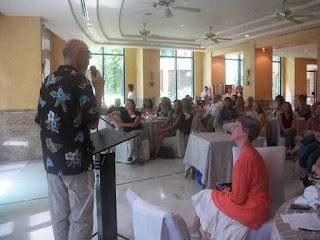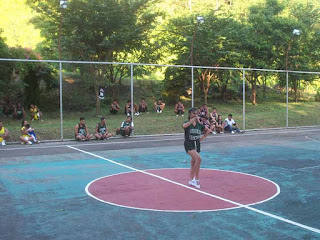 game. Big man Chris Atadora led Geary with 49 points, but this was not enough, as the diminutive captain of Way, Roy Baludbod, scored an even more amazing 52 points! The combined teams’ points are 20 more than the next highest scoring game so far. Add it up, and Atadora and Baludbod accounted for 101 – over 56% – of the 180-point total score. If we had kept track of assists, Baludbod would have looked even more impressive, as he dished off plenty of passes to teammates for layups.
game. Big man Chris Atadora led Geary with 49 points, but this was not enough, as the diminutive captain of Way, Roy Baludbod, scored an even more amazing 52 points! The combined teams’ points are 20 more than the next highest scoring game so far. Add it up, and Atadora and Baludbod accounted for 101 – over 56% – of the 180-point total score. If we had kept track of assists, Baludbod would have looked even more impressive, as he dished off plenty of passes to teammates for layups.In the second game, fourth seeded Battery Hearn surprised regular season champion Battery Grubbs 67-64. Hearn played the game with only six players while Grubbs was able to stay fresher by substituting among 10 players. Hearn got off to a 6-0 lead and held through the first half. Weariness started to show early in the third quarter, and Hearn fell behind by nine points, and it looked to be all but over. Incredibly, they managed to whittle away and in the end pulled off the upset. Including the 4th/5th qualifier game last week which Hearn won 58-56, the first three playoff games were settled by differences of two, two, and three points. Talk about exciting basketball!
The second pair of games on Wednesday did not come close t
 o Tuesday’s matches for excitement. Needing a win to stay alive, Hearn rushed out to an 18-3 lead and coasted to a 72-60 win that was never as close as the final score would seem to indicate. In the other contest, Geary drubbed Way 101-71 in another must-win game. Atadora was the high scorer, getting 44 for Geary. The only highlight for Way was Baludbod, who finished with 42. Atadora is one of the biggest and possibly the most athletic man in the tournament, and Way had no answer. On the other hand, Baludbod was, at five feet, three and a half inches (1.61 meters), the shortest but certainly the most exciting player on the court once again. The two men combined for half of the scoring in this game.
o Tuesday’s matches for excitement. Needing a win to stay alive, Hearn rushed out to an 18-3 lead and coasted to a 72-60 win that was never as close as the final score would seem to indicate. In the other contest, Geary drubbed Way 101-71 in another must-win game. Atadora was the high scorer, getting 44 for Geary. The only highlight for Way was Baludbod, who finished with 42. Atadora is one of the biggest and possibly the most athletic man in the tournament, and Way had no answer. On the other hand, Baludbod was, at five feet, three and a half inches (1.61 meters), the shortest but certainly the most exciting player on the court once again. The two men combined for half of the scoring in this game.In addition to A
 tadora, Battery Geary has another great player, captain Jerry Constantino, the 2008 MVP. Constantino did not play for much of the first game between Geary and Way due to nagging injuries, which possibly figured in Geary’s loss. He is very much like Baludbod, small and fast, and a great strategist, scorer, and assist man. Teamed with big-man Atadora, we think they are the team to beat should both players remain healthy and available for the rest of the tournament. Second favorite is regular season champ Grubbs, with no single standout player, a more balanced team able to substitute at will and remain fresher than any of the other teams.
tadora, Battery Geary has another great player, captain Jerry Constantino, the 2008 MVP. Constantino did not play for much of the first game between Geary and Way due to nagging injuries, which possibly figured in Geary’s loss. He is very much like Baludbod, small and fast, and a great strategist, scorer, and assist man. Teamed with big-man Atadora, we think they are the team to beat should both players remain healthy and available for the rest of the tournament. Second favorite is regular season champ Grubbs, with no single standout player, a more balanced team able to substitute at will and remain fresher than any of the other teams.A quick rain during Thursday afternoon left enough water on the uncovered basketball court to force a postponement of the third and deciding games for all four teams. Since Christmas is near and many players – as well as faithful scorekeeper Resty – will be off-island for time with their families, it was decided to postpone the remainder of the tournament. Play will resume after Christmas.
A rare tropical storm (Sendong/Washi) moved through Mindanao this weekend. We say rare because such storm systems typically swing north before reaching the southern Philippines. Although the winds apparently never got high enough to be classified a typhoon, it dumped a typical month’s worth of rain in 12 hours. We are very sad to see news reports that 652 are reported dead and around 800 missing, mostly due to flooding, and mostly in the cities of Cagayan de Oro and Iligan in the large southern island of Mindanao. Many of them were caught unaware while sleeping, due to suddenly rising floodwaters during the night. Storms such as this occur on average only once every 12 years in this part of the country.
The further north you are in the Philippines, the more likely you are to be in the path of a Pacific Cyclone. Batanes, a small island group situated halfway between Northern Luzon and Taiwan, seems to be in the path of almost every typhoon that hits the Philippines. Pictures of Batanes show treeless hills and stone buildings, making it appear more like Scotland than the rain-forested islands one sees elsewhere in the Philippines.
A quick geography lesson: Luzon is the main island of the northern Philippines. Luzon is the most populated of the islands, with Manila near its center. It comprises about 35% of the total land area of the country. Mindanao is the main island in the south, and comprises almost 32% of the land area. The remaining 7,000+ islands, mostly in the central Philippines (Visaysas Region) make up less than one third of the land mass. Our home state, Minnesota, is 10% larger than Luzon and Mindanao combined, but has about one-twentieth of the population.
By the way, some of you have asked about how we are doing. Corregidor is near Manila and hundreds of miles north of the storm, so we got some clouds and maybe a little rain, but without access to news we would not have know anything happened down south.
Christmas is now less than a week away, and as usual we plan to spend it here on The Rock with our friends. The annual all-island Christmas party was held last Monday evening, and we were glad that friends Bill and Midge were here to join the festivities. Good food and entertainment, an enjoyable evening! Having spent most of our lives in Minnesota and Michigan, it is still a little hard to think of Christmastime when the average high temperature is 85 and the average low 75 degrees Fahrenheit.

We have included a photo that was taken in front of Middleside Barracks where Steve’s father Walter resided before the war. It is only a few hundred meters from our house. The photo will be on the back cover of our book about Walter, Honor, Courage, Faith: A Corregidor Story, which we anticipate will be published and in Philippine bookstores early next year. We’ll keep you posted!
We wish all of our family and friends a truly Maligayang Pasko! Merry Christmas!
Steve and Marcia on the Rock



















































